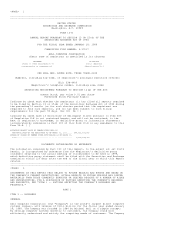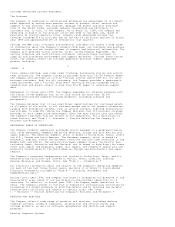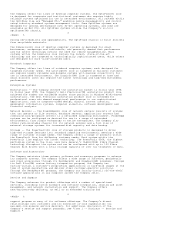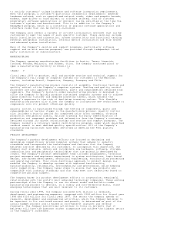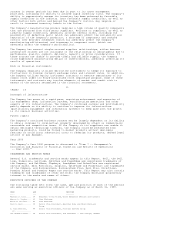Dell 1998 Annual Report Download - page 8
Download and view the complete annual report
Please find page 8 of the 1998 Dell annual report below. You can navigate through the pages in the report by either clicking on the pages listed below, or by using the keyword search tool below to find specific information within the annual report.to satisfy customers' unique hardware and software integration requirements.
With this program, a customer's particular integration requirements (whether
hardware related, such as specialized network cards, video and graphic boards,
modems, tape drives or hard drives; or software related, such as customer
proprietary software applications or drivers) can be satisfied at the time the
customer's systems are manufactured. This is in addition to the Company's
ReadyWare program, which is a collection of popular software applications and
interface cards that can be factory-installed.
The Company also offers a variety of on-site installation services that can be
customized to meet the needs of each specific customer. These services include
basic installation and orientation, system connectivity and functional testing,
external peripheral installation, internal device installation and file server
and advanced system installation.
Many of the Company's service and support programs, particularly software
support and on-site service programs, are provided through independent third
party contractors or subcontractors.
MANUFACTURING
The Company operates manufacturing facilities in Austin, Texas; Limerick,
Ireland; Penang, Malaysia; and Xiamen, China. The Company announced plans to
open a manufacturing facility in Brazil in
7
<PAGE> 9
fiscal year 2000 to produce, sell and provide service and technical support for
the Company's full range of computer systems for customers in the Mercosul
region, including Brazil, Argentina, Uruguay, Paraguay and Chile.
The Company's manufacturing process consists of assembly, functional testing and
quality control of the Company's computer systems. Testing and quality control
processes are also applied to components, parts and subassemblies obtained from
suppliers. The Company's build-to-order manufacturing process is designed to
allow the Company to quickly produce customized computer systems and to achieve
rapid inventory turnover and reduced inventory levels, which lessens the
Company's exposure to the risk of declining inventory values. This flexible
manufacturing process also allows the Company to incorporate new technologies or
components into its product offerings quickly.
Quality control is maintained through the testing of components, parts and
subassemblies at various stages in the manufacturing process. Quality control
also includes a burn-in period for completed units after assembly, on-going
production reliability audits, failure tracking for early identification of
production and component problems and information from the Company's customers
obtained through its direct relationships and service and support programs. The
Company conducts a voluntary vendor certification program, under which qualified
vendors commit to meet defined quality specifications. All of the Company's
manufacturing facilities have been certified as meeting ISO 9002 quality
standards.
PRODUCT DEVELOPMENT
The Company's product development efforts are focused on designing and
developing competitively priced computer systems that adhere to industry
standards and incorporate the technologies and features that the Company
believes are most desired by its customers. To accomplish this objective, the
Company must evaluate, obtain and incorporate new hardware, software, storage,
communications and peripherals technologies that are primarily developed by
others. The Company's product development team includes programmers, technical
project managers and engineers experienced in system architecture, logic board
design, sub-system development, mechanical engineering, manufacturing processing
and operating systems. This cross-functional approach to product design has
enabled the Company to develop systems with improved functionality,
manufacturability, reliability, serviceability and performance, while keeping
costs competitive. The Company takes steps to ensure that new products are
compatible with industry standards and that they meet cost objectives based on
competitive pricing targets.
The Company bases its product development efforts on cooperative, meaningful
relationships with the world's most advanced technology companies. These working
partnerships allow the Company to use its direct model and build-to-order
manufacturing process to deliver, on a timely and cost-effective basis, those
emerging technologies that are most relevant to its customers.
During fiscal year 1999, the Company incurred $272 million in research,
development and engineering expenses, compared with $204 million for fiscal year
1998 and $126 million for fiscal year 1997. The amount the Company spends on
research, development and engineering activities, which the Company believes to
be important to its continued success and growth, is determined as part of the
annual budget process and is based on cost-benefit analyses and revenue
forecasts. The Company prioritizes activities to focus on projects that it
believes will have the greatest market acceptance and achieve the highest return
on the Company's investment.


